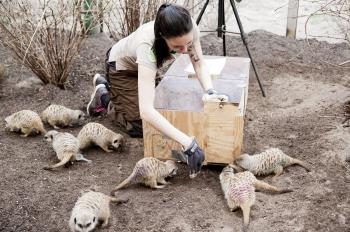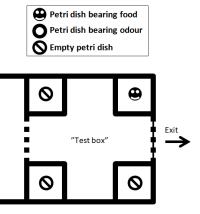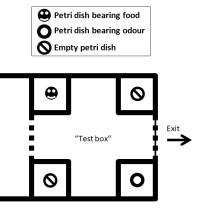Methods


4 male meerkats housed at Kolmården Wildlife Park, Sweden, were used. The animals were habituated to me and the test arena prior to the start of the study.
The experiments reported here are based on the classical buried-food test, a widely used behavioural test to assess the ability of laboratory rodents to find buried food using their sense of smell. The test is commonly used with mice to confirm the ability to smell certain odours and relies on the natural tendency of an animal to use olfactory cues and to dig when foraging.
The general setup of the study was to use a foursquare test arena that contained four small compartments, one in each corner of the arena. The approach was to place either food, odour or both in one of the corners and then fill all corners with wood chips. This would allow for assessing the ability of the meerkats to find the hidden food and/or odour using only their sense of smell, as judged by the displayed digging behaviours. This was done by recording in which of the four corners the animal started to dig for the first time.
Olfactory detection of real food

In order to test the meerkats’ ability to detect buried food using only olfactory cues, one of the corners contained food while the remaining three corners were empty.
The following food types were used: banana (Musa paradisiaca), mouse (Mus musculus), chicken (Gallus gallus domesticus) and mealworms (larvae of the mealworm beetle, Tenebrio molitor).
Discrimination between real food and a food odour component

In order to test the meerkats’ ability to discriminate between the odour of real food and a food odour component, one of the corners contained food and another corner contained an odour (food odour component or control odour). The remaining two corners were empty.
The following food types were used: banana (Musa paradisiaca) and mouse (Mus musculus).
The following odours were used: iso-pentyl acetate ("banana odour") and cyclamen aldehyde (lily-of-the-valley-like odour, "control odour").
Food and odour were presented in the following combinations: banana and iso-pentyl acetate, mouse and iso-pentyl acetate, banana and cyclamen aldehyde.
Association between real food and a novel odour

In order to test the meerkats’ ability to learn to associate a food type (banana) with a novel odour (eugenol), two steps were performed. In the first step, one of the corners contained banana plus eugenol, while the remaining three corners were empty. In the second step, one of the corners contained eugenol only, while the remaining three corners were empty.
The following food type was used: banana (Musa paradisiaca).
The following odour was used: eugenol (clove-like odour).
Responsible for this page:
Director of undergraduate studies Biology
Last updated:
05/02/18
